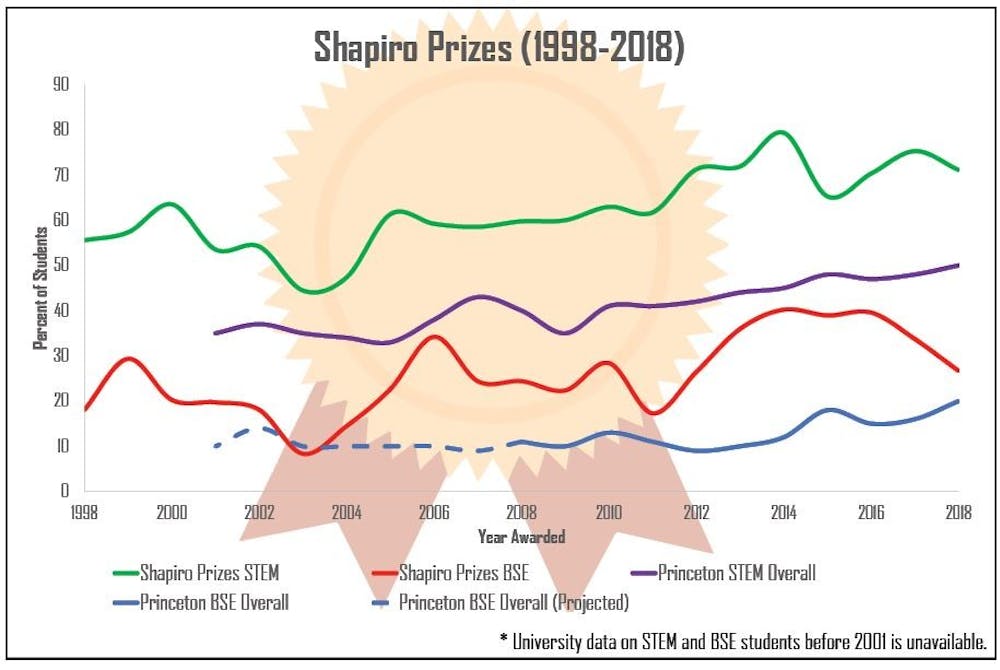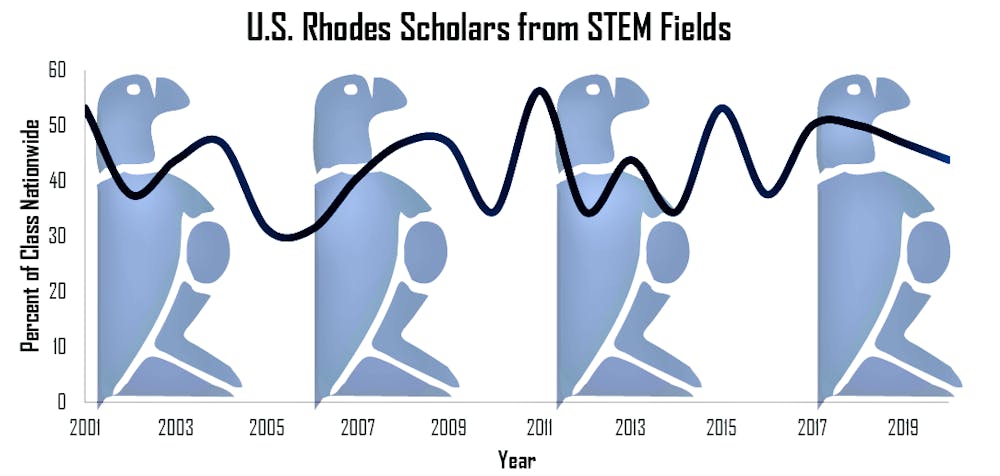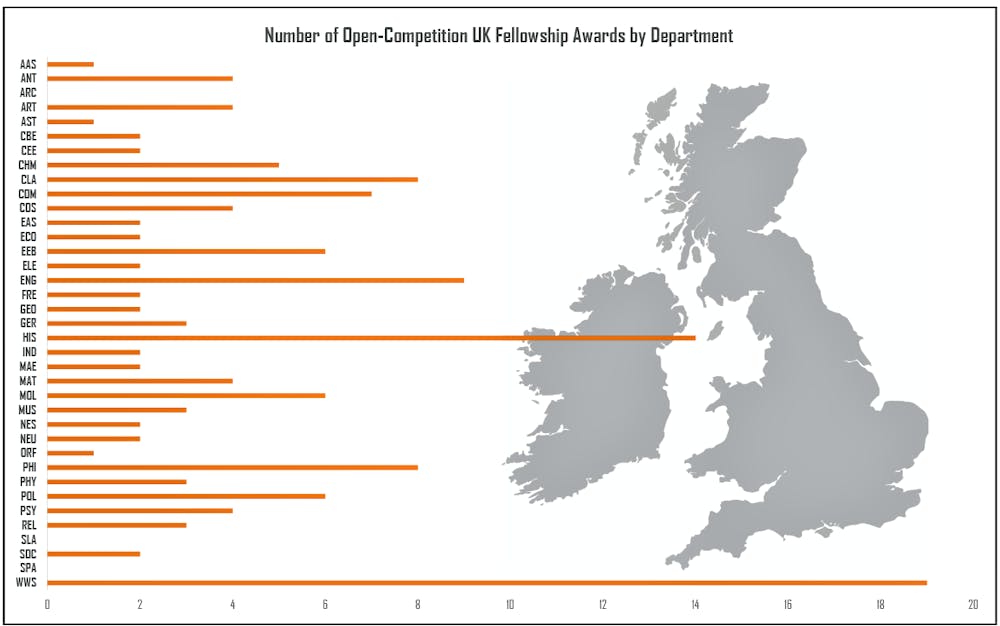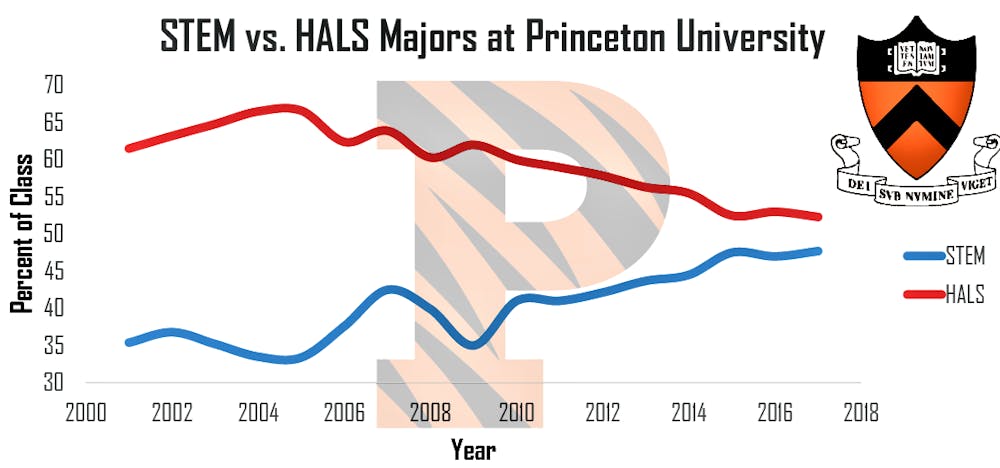Opening Exercises kicks off awards season at the University. An administrator takes the stage to call up a half dozen students to receive prizes for reaching the top of their classes. Other awards are presented in the following weeks that include Shapiro prizes, Rhodes scholarships, and so on, until the senior class’s valedictorian is named. The competition for academic awards is supposed to be one of the most meritocratic processes in higher education, hence why their winners are revered. You’re either the best, or you’re not.
But the selection processes for these awards have shortcomings. A slew of traceable factors beyond anyone’s control help or hinder students pursuing these honors. I reviewed more than 1,000 pages of documents during an 18-month investigation to track who’s been winning nine prestigious academic awards at the University over the past twenty years.
Students concentrating in science, technology, engineering, and mathematics (STEM) were more likely to win awards for high GPAs, while students concentrating in the humanities, arts, languages, and social sciences (HALS) more often won awards with holistic selection criteria. These results defy the fact that STEM students tend to have lower GPAs on average than HALS students. The explanation as to why this happens is quite complicated.
I interviewed two dozen people, including alumni, professors, administrators, education experts, past winners, and almost every Princetonian who had a fellowship at the University of Oxford last spring.
Collectively, they told me about the problems in award selection processes that often give away hundreds of thousands of dollars in prize money. Some committee members admitted that they were unaware of the larger trends in higher education that impact their work or didn’t previously understand their importance.
Teaching styles, grading disparities, high school backgrounds, and departmental politics all play roles in who’s crowned Old Nassau’s top students. I will explore each of these factors in depth for subsequent columns. But first, I’ll give a brief overview of who at Princeton is winning the nine prestigious academic awards to show why their results are so baffling.
Class Legacy Prizes
Five to seven students each year receive the Freshman First Honor Prize, George B. Wood Legacy Sophomore Prize, George B. Wood Legacy Junior Prize, and the Class of 1939 Princeton Scholar Award (which I will collectively call “Class Legacy Prizes”). These awards are given for “exceptional academic achievement” during their namesake years or for having the “highest academic standing for all preceding college work at the University” in the case of the Scholar Award.

Just 29 percent of Class Legacy Prize recipients since 2000 — of almost 120 total — concentrated in HALS subjects. The math, physics, and molecular biology departments accounted for four out of every 10 winners. Economics led for the HALS departments, with Classics a distant second.
Senior Associate Dean of the College Claire Fowler declined to comment on these statistics in a 2018 interview.
Valedictorian
The University’s valedictorian has one of the highest cumulative GPAs of all students in their class by their senior spring. Administrators distinguish between finalists by asking their departments for letters of recommendation and considering the A+ statements that their professors wrote.

This award is split approximately fifty-fifty between STEM and HALS students since 2000 (though STEM prevails when extending the count back to 1997, the earliest online record).
Only 20 students received this award, so a small sample size may be responsible for its evenhanded outcomes.
Shapiro Prizes and Phi Beta Kappa

Graphic Credit: Harsimran Makkad / The Daily Princetonian
The Shapiro Prize is awarded to 3 percent of underclass students based on a combination of their grades and the breadth, depth, and rigor of their courses. The top 10 percent of the graduating senior class is inducted into Phi Beta Kappa, provided that they also meet the organization’s membership requirements.
In previous columns, I wrote that the STEM departments disproportionately dominated both awards — especially math — but to a lesser degree in Phi Beta Kappa. Students in departments that graded the highest were often the most likely to receive them. Small departments in the humanities had the best win rates, compared to STEM, where smaller departments ranked near the middle or bottom. Almost half of Phi Beta Kappa inductees had previously won a Shapiro Prize.
Pyne Prize
The Pyne Prize — Princeton’s highest award — goes to students who have distinguished themselves in “excellence in scholarship, character, and effective support of the best interests of Princeton University.” It consists of funds equaling the “comprehensive fee for one academic year” — which would put it somewhere in the ballpark of $76,000.
The Office of the Dean of Undergraduate Students (ODUS) puts out a call for nominations to academic department chairs, program chairs, residential college deans, and other people in campus life departments.
“Our objective is always to select the student or students with the strongest combination of talents,” Dean of Undergraduate Students Kathleen Deignan wrote in an email.
Three-quarters of the nearly 40 Pyne Prize recipients from the past 20 years were HALS concentrators. Less than 8 percent were BSE students, and an engineer has not won it since 2008. A trophy plaque in the Friend Center indicates that engineers used to win the Pyne Prize once every three years on average from 1980–1999, back when they composed a smaller fraction of the student body. But the win rate is now half of that despite the School of Engineering’s tremendous growth. History and the Woodrow Wilson School had the most winners of all departments.
Dean Deignan declined to comment on these statistics and said that records of past nominees weren’t available.
“Can a person really pick out someone who’s clearly the all-around best student in the way described in the Pyne Prize?” former President of Princeton Harold Shapiro GS ’64 asked. While he said that faculty do their best to choose deserving students, he fears that “a lot of noise” comes into the selection process. He continued, “I can’t figure out why some parts of the University are really interested in promoting their students for the Pyne Prize, and you don’t hear from other parts."
Sachs scholar Hans Hanley ’18, an electrical engineering major, said that he didn’t think STEM departments pay much attention to these kinds of academic awards.
Sachs Scholarship
The Class of 1960 started the Sachs Scholarship in honor of Dan Sachs ’60, a Rhodes Scholar who died of cancer. It funds two years of study at Worcester College at the University of Oxford for one senior Princetonian each year, and the Sachs Global Scholarship was recently created to support one to two years of study abroad anywhere in the world.
A committee of past Sachs scholars reads applications and interviews finalists to “identify those members of the graduating class whose tenures of the scholarship would be most in keeping with Dan Sachs’s qualities.” They look for students whose work will further the public’s interests.
Eight-tenths of the 30 Sachs scholars since 2000 were HALS concentrators. That fraction remains unchanged if the record is extended back to the scholarship’s establishment in 1970. Prior to Kaitlin Stouffer ’13, a computer science major selected in 2012, an engineer had not won since 1986.
“If I look back in time, there was a significantly higher representation of people associated with politics or policy,” scholarship adviser Matthew Stewart ’85 told me. He explained that past selection committees once adhered to the rigid idea that public service was limited to governmental work. About two decades ago, he said that the committee adopted “a much more open-minded view.”
Rhodes Scholarship

Harsimran Makkad
The will of British diamond magnate Cecil Rhodes created a scholarship for 32 students from the United States — in addition to dozens more from other former British colonies — to study at Oxford for several years.
Applicants first seek endorsements from their universities. If approved, they can choose to compete in one of 16 districts across the country — either the one of their hometown or the district in which their university is located. Some districts are believed to be more competitive than others.
District 1, for example, is known for attracting applicants from Harvard, Amherst, the Massachusetts Institute of Technology, and other top-notch Boston-area universities. On the other hand, some western districts have fewer colleges in general or hardly any students attending elite colleges.
District committees read and rank all of the applications before inviting around a dozen finalists for interviews. They then independently select two winners per district. Students are judged by the criteria for academics and character defined in Cecil Rhodes’ will.
“Generally, people who ultimately won were perceived of as winners from reading the materials from the outset. The people who lost usually did not do as well on that first reading,” said Stephen Joel Trachtenberg, a former Rhodes district chairman.
Only 14 percent of Princeton's three dozen American Rhodes scholars concentrated in STEM subjects. In 2007, Landis Stankievech ’08, a mechanical and aerospace engineering major, won a Rhodes Scholarship in Canada. But Princeton hasn’t had an American engineer become a Rhodie since Benjamin Jones ’95 was selected in 1994, according to trophy plaques in the Friend Center. Engineers used to receive Rhodes scholarships every two or three years from 1980–1999.
Jones didn’t respond to my interview request.
For reference, a third of Harvard’s winners and a quarter of Yale’s were STEM students, though each had more winners overall. Common Data Set statistics show that — like Princeton — HALS students dominated by a ratio of 2:3 at both universities in the past, meaning that this skew in their student bodies lowered the number of STEM students in their potential applicant pool. Nationwide, 43 percent of all Rhodes scholars since 2000 majored in STEM subjects.
“We have never showed any preference for students in one academic area or another,” Secretary to the American Rhodes Trust Elliot Gerson said. He stated that any changes in winners’ disciplines “has nothing to do” with the Rhodes’ selection criteria.
Princeton’s nomination committee chair Professor Benjamin Morrison deferred comment to Director of Fellowship Advising Deirdre Moloney, who declined to provide application statistics. Former president Shirley Tilghman — also a member of Princeton’s nomination committee — declined to comment. I tried to obtain recent administrative Rhodes scholarship records from the Mudd Manuscript Library, but they are sealed until 2043.
Marshall Scholarship

Harsimran Makkad
The United Kingdom’s parliament thanked the United States for the Marshall Plan by establishing a scholarship program to fund one to three years of graduate study at any British university.
Like the Rhodes Scholarship, applicants first seek institutional endorsements. Next, eight regional committees review their applications and invite finalists for interviews. Candidates are screened for their academic merit, leadership, and ambassadorial potential.
Two-thirds of Princeton’s Marshall scholars were HALS concentrators, matching Harvard and Yale. Fifty-five percent of all Marshall scholars nationwide majored in these subjects since 2000. Less than one in 10 of Princeton’s winners were engineers, but a trophy plaque in the Friend Center shows that they won twice as frequently in 1980–1999 as they do today.
“I don’t feel defensive about [this data] at all. These things emerge as they emerge. There are trends over time as to what people of a type are to do,” Marshall Scholarship chair Christopher Fisher told me. He suggested that study abroad was more conducive for some fields of study over others. “We don’t have any prescribed model that we’re working [with] as to what the output should look like,” he said.
Gates Cambridge

Harsimran Makkad
The Bill and Melinda Gates Foundation started a scholarship program at the University of Cambridge in 2000 to attract students who want to improve the lives of others.
Unlike the Rhodes and Marshall scholarships, the Gates is integrated within Cambridge’s admissions process. Students first submit graduate applications and complete a section for the Gates scholarship. Departments rank them by their academic merit. They send them to Gates shortlisting committees — which are divided into broad categories — to decide who they will interview.
44 percent of Princeton’s 50 American Gates Cambridge scholars since 2001 were STEM concentrators, and 12 percent were engineers. Harvard had about the same proportion of STEM students, while Yale lagged behind at 30 percent.
Broader trends in the Gates selection process are likely responsible for the higher fraction of STEM winners. Three-quarters of American scholars were HALS concentrators in the scholarship’s inaugural year versus just one-third in 2019. Half of the University’s Gates scholars in 2010–2020 studied STEM, but only a third did in 2001–2009.
Gates Cambridge Program Director Jim Smith declined to comment on these statistics.
Overall Fellowship Trends

Harsimran Makkad
The Woodrow Wilson School took first place in these four major U.K. fellowships with 19 winners, and History was second at 14. Third place went to Classics at eight. HALS departments have garnered almost two and a half times as many of these U.K. fellowships as STEM departments.
In general, students from small HALS departments appeared to be uniquely overrepresented among the winners of these nine awards compared with the fraction of the student body that they compose. For example, concentrators in Religion — which on average has only 12 students per class year — have won three Pyne Prizes. Comparative Literature concentrators — who usually number less than two dozen per year — have received four American Rhodes scholarships. Classics, which is of a similar size, has the third-highest Phi Beta Kappa induction rate. Small natural science departments like Geosciences and Astrophysics weren’t nearly as decorated.
The chairs of the Classics and comparative literature departments didn’t respond to my interview requests.
Multiple engineering professors and Peter Bogucki, Associate Dean of Undergraduate Affairs for the School of Engineering, declined to be interviewed.
Moloney saw no cause for alarm in fellowship outcomes. She emphasized in an email that the Gates Cambridge, Stanford’s Knight-Hennessy program, and National Science Foundation Graduate Research Fellowships are becoming popular with STEM students.
“We are seeing increased interest from STEM students for many awards, including Rhodes, Gates, and Fulbright,” she wrote.
Frank Ordiway ’81, Moloney’s predecessor, declined to be interviewed.
Analysis

Harsimran Makkad
Imagine having two identical students who begin their careers at the University. One majors in a STEM subject and the other a HALS subject. Their academic experiences will differ in the grading practices they encounter, emphasis on extracurricular activities, career advice they receive, amount of free time available to them, and how they interact with their professors. The cumulative impact of these factors significantly influences their résumés — or if they even submit them to a particular program — and how competitive they are when competing head-to-head against their peers of other subjects.
Grading is a prime example that I’ll expand upon in my next column. Princeton’s statistics show that HALS departments on average give higher grades than STEM departments. Princetonians already know this. But what about the people who judge their applications? The answer — as I learned in interviews — is “sometimes.”
These nine awards that I’ve selected are an integral part of higher education even if very few students actually win them. They recognize outstanding achievement and set an example for classmates to follow, not to mention the thousands of dollars they give away. Preserving their integrity — so that they’re relatively free of “a lot of noise” — is necessary to maintain the meritocratic ideal that universities try to create.
It is impossible to statistically prove that any one factor causes the trends that I’ve highlighted. Doing so would require reading private documents, gaining unprecedented access to finalists’ competition interviews, and using telepathy to read judges’ minds when they read applications. There are simply too many variables to quantitatively account for.
But I will demonstrate in my upcoming columns that GPAs, disciplines’ varying academic cultures, and differences in high school backgrounds affect how the two theoretically identical students I described — who set their sights on these awards from their freshman years — will fare. It will become increasingly clear that their fields of study can help or hinder their chances of winning them.
Methods
Sometimes the topics that you cover as a student journalist intersect with your own life. I originally thought of writing about this topic during my sophomore year; I had found trophy plaques in the Friend Center showing that engineering students were winning major academic awards less frequently since 2000. I began compiling statistics on this subject in the fall of my junior year and spent my spring study abroad at Oxford interviewing past award recipients. I enjoyed my experience across the pond so much that I wanted to return after graduation.
As a point of full disclosure, I submitted applications to the Sachs and Gates Cambridge scholarships this past fall. Both were rejected. I will clearly outline my methodology so that my investigation is reproducible should anyone feel that I manipulated data out of spite. I have never applied to or been eligible for the other seven awards.
Before analyzing the data, I imagined this study as a glorified coin toss — heads for HALS students and tails for STEM. From applicants’ perspectives, the selection processes for academic awards are completely random. Over a long period of time, their outcomes would be evenhanded if they were neutral.
Of course, the outcomes aren’t equal because of a variety of factors. The STEM/HALS divide in the student body has ranged from 40/60 percent to 50/50 percent. I also can’t control departments’ application rates, faculty connections, external competition, and the quality of fellowship advising offices between universities. But I will discuss them in later columns.
The valedictorian, Pyne Prize, Sachs scholarship, and Class Legacy Prize recipients were posted online in annual University press releases. I found information for the Rhodes, Marshall, and Gates scholars from their programs’ websites.
I focused my analysis on these nine awards because of their prominence, the completeness of their records, and their high numbers of winners. I would’ve liked to track more awards — such as the Fulbright scholarship or Labouisse Prize — but could not compile lists of their recipients stretching back 20 years. I also wanted to investigate job and professional school outcomes but could not obtain that data.
I didn’t analyze several U.K. fellowships that do have complete records, like the Churchill Scholarship and Ertegun Programme. They fund graduate studies at Oxbridge for only STEM students in the former and humanities students in the latter. I assumed that any rational person who applied to them also would have applied to one (or more) of the four U.K. fellowships that I tracked to maximize their chances of winning any scholarship. If Princeton STEM students were, say, hardly winning in the Gates scholarship but crushing the Churchill competition, it would raise questions about why they were less successful when going head-to-head with HALS students.
My description of awards’ application processes are brief summaries, and I have neglected many of the finer details. I never found any evidence to suggest that selection committees were prejudiced against students of particular disciplines. My data focuses on factors affecting students before they apply and how selection criteria influence outcomes.
I will single out the Rhodes scholarship several times in my upcoming columns. I don’t do so to be overly critical of its practices. As the oldest international scholarship program, it simply has generated the most research and discussion.
This is the third article in a series examining the outcomes of academic awards.
Liam O’Connor is a senior geosciences major from Wyoming, Del. He can be reached at lpo@princeton.edu.







